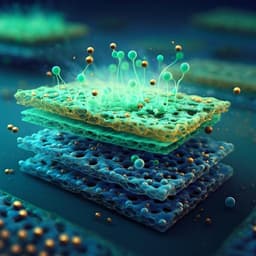
Chemistry
Atomic-precision Pt6 nanoclusters for enhanced hydrogen electro-oxidation
X. Wang, L. Zhao, et al.
This groundbreaking research conducted by Xiaoning Wang, Lianming Zhao, Xuejin Li, Yong Liu, Yesheng Wang, Qiaofeng Yao, Jianping Xie, Qingzhong Xue, Zifeng Yan, and Xun Yuan introduces ultrasmall triphenylphosphine-stabilized Pt6 nanoclusters that revolutionize electrocatalytic hydrogen oxidation in alkaline solutions. These nanoclusters not only showcase remarkable mass activity and stability but also offer significant advantages over traditional Pt single atoms and nanoparticles.
~3 min • Beginner • English
Introduction
Platinum is highly active for hydrogen electrocatalysis but is scarce and costly, motivating atomic-level engineering to minimize Pt usage while maximizing activity and durability. The study targets the hydrogen oxidation reaction (HOR) in alkaline media, where kinetics are sluggish on Pt and CO poisoning is severe. The research question is whether atomically precise, ligand-stabilized Pt6 nanoclusters can provide optimal binding energetics and superior performance compared to Pt single atoms (SAs) and larger nanoparticles (NPs), and whether triphenylphosphine (PPh3) ligands can beneficially tune electronic structure and stabilize clusters to enhance activity, durability, and CO tolerance.
Literature Review
Alkaline HOR mechanisms generally follow Tafel–Volmer or Heyrovsky–Volmer pathways with the Volmer step often rate-determining due to strong hydrogen binding on platinum group metals. The hydrogen binding energy (HBE) and hydroxyl binding energy (OHBE) are widely considered key activity descriptors. Prior efforts have explored non-PGM catalysts, alloying, and support effects to tune these descriptors, as well as size effects from single atoms to nanoparticles. Ligand effects on heterogeneous nanocatalysis are known to influence electronic and steric properties, yet atomically precise Pt clusters with defined ligands for alkaline HOR, and their CO tolerance, remain less explored. This work addresses that gap by leveraging PPh3-stabilized Pt6 nanoclusters.
Methodology
Synthesis: Pt6 nanoclusters (PtNCs) were synthesized by reducing H2PtCl6·6H2O in a mixed solvent with triphenylphosphine (PPh3) using borane–tert-butylamine complex (TBAB) as reductant, yielding a dark brown Pt cluster solution. Clusters were immobilized on carbon black (Vulcan XC-72R) by adsorption to form PtNCs/C (Pt loading ~2.5 wt.% by TGA). Comparators included Pt single atoms on carbon (Pt1SAs/C; ~2.2 wt.% Pt), large Pt nanoparticles on carbon (PtNPs/C; average size ~4.4 nm; ~5.4 wt.% Pt), GSH-ligand Pt NCs (larger ~1.9 nm), and a calcined ligand-free variant PtNCs/C-550 (550 °C under Ar for 5 h). A NaBH4-reduced PtNPs/C control was also prepared.
Characterization: UV–vis spectroscopy, ESI-MS (including isotopic pattern matching to Pt6(PPh3)4Cl6), TEM, HAADF-STEM (including aberration-corrected imaging) for morphology and size (~1 nm clusters, well-dispersed), elemental mapping (Pt and P distribution), PXRD (absence of Pt peaks for Pt6NCs/C and Pt1SAs/C; clear Pt reflections for PtNPs/C and commercial 20% Pt/C), XPS (Pt 4f analysis showing Pt0/Pt2+ in PtNCs/C with 0.4 eV positive shift vs PtNPs/C indicating stronger Pt–P interactions; ligand removal lowered binding energy), and TGA for loadings.
Electrochemistry: HOR evaluated in H2-saturated 0.1 M KOH at room temperature using RDE (4 mm GCE, 400–3600 rpm), with loadings: PtNCs/C 5 µgPt cm−2 (optimized), Pt/Ccom 10 µgPt cm−2. LSV from −0.04 to 0.5 V vs RHE at 5 mV s−1 (iR-corrected). Kinetic currents derived via Koutecky–Levich analysis; exchange current density via Butler–Volmer fitting in micro-polarization region. ECSA from Hupd charge in CV (Ar-saturated 0.1 M KOH, 0.005–1.1 V vs RHE, 50 mV s−1). Durability by accelerated durability test (2000 CV cycles between 0.005–0.6 V at 100 mV s−1) and chronoamperometry at 60 mV overpotential for 10 h. CO tolerance assessed by introducing 5% CO into H2 during chronoamperometry at 100 mV; CO stripping performed by adsorbing CO at 0.1 V then scanning in fresh electrolyte.
Computations: Spin-polarized DFT using DMol3 and CASTEP. Ligand modeled as P(CH3)3. Models: Pt1 as Pt(P(CH3)3)2; Pt6 cluster as Pt6(P(CH3)3)4Cl5 (octahedral Pt6 with mixed Pt–P and Pt–Cl coordination); PtNPs modeled as Pt(111) slab (p(4×4), 4 layers); ligand-free Pt6 octahedron for PtNCs/C-550. PBE GGA, DNP basis, DSPP pseudopotentials, Grimme D2 dispersion; CASTEP with 750 eV cutoff and norm-conserving pseudopotentials for DOS and charge density. k-point sampling per model. Transition states via LST/QST with frequency confirmation. Calculated d-band centers, adsorption energies (H, OH, CO), free energies ΔG including ZPE and entropy at 298 K.
Key Findings
- Pt6NCs/C exhibits rapid HOR kinetics, reaching 2.7 mA cm−2 at 50 mV overpotential vs RHE, outperforming commercial Pt/C (1.8 mA cm−2 at 50 mV).
- From Koutecky–Levich analysis at 50 mV: kinetic current density jk = 18.2 mA cm−2 and mass-specific kinetic current km = 3658 A g−1, approaching the theoretical 2e− process slope (experimental 5.08 vs theoretical 4.87 cm2 mA−1 s1/2).
- Mass-specific activity enhancement: Pt6NCs/C is ~9.1× Pt/Ccom (402 A g−1) and ~7.4× PtNPs/C (496 A g−1); among the highest reported for monometallic HOR electrocatalysts under these conditions.
- Tafel/kinetic analysis: jk at 20 mV is 3.62 mA cm−2 for Pt6NCs/C. Mass-normalized exchange current density j0,m = 646.3 A g−1 (vs 22.0 for Pt1SAs/C, 164.5 for PtNPs/C, 113.1 for Pt/Ccom). Area-specific exchange current jos = 1.546 mA cm−2 (vs 0.149, 0.446, 0.351 mA cm−2 for Pt1SAs/C, PtNPs/C, Pt/Ccom respectively), confirming superior intrinsic activity.
- Optimal size principle: Pt6 clusters outperform both smaller single atoms and larger nanoparticles for alkaline HOR.
- Ligand effect: Removing PPh3 by calcination (PtNCs/C-550) lowers activity (jkm = 2128 A g−1; j0,m = 462.2 A g−1) and reduces CO tolerance, indicating PPh3 ligands enhance performance beyond structural stabilization (self-optimizing ligand effect).
- Durability: After 2000 ADT cycles, half-wave potential shift is 22.5 mV for Pt6NCs/C vs 34.5 mV for Pt/Ccom; after 10 h chronoamperometry at 60 mV, Pt6NCs/C retains 98.3% current, while Pt/Ccom loses >42%.
- CO tolerance: Under 5% CO in H2 at 100 mV, Pt/Ccom current drops to 0% and does not recover; Pt6NCs/C retains 77% current and shows a 170 mV negative shift in CO stripping peak vs Pt/Ccom, indicating weaker CO adsorption. PtNCs/C-550 shows poorer CO tolerance than Pt/Ccom, highlighting the crucial role of PPh3.
- Electronic structure and energetics (DFT): PPh3 coordination induces electron withdrawal from Pt (XPS positive shift) and downshifts Pt d-band center (Pt6NCs −2.842 eV vs Pt1SAs −0.540 eV; PtNPs −2.689 eV), weakening H and CO binding. Hydrogen adsorption free energy ΔGH on Pt6NCs is near optimal (−0.07 eV) vs Pt1SAs (0.71 eV) and PtNPs (−0.21 eV). CO adsorption energy is least negative on Pt6NCs (−1.10 eV) vs PtNPs (−1.46 eV) and ligand-free Pt6 (−1.87 eV). Stronger OHBE on Pt6NCs than on PtNPs aids CO oxidation. Overall, energetics facilitate the Tafel–Volmer pathway and lower the barrier for water formation compared to SAs and NPs.
Discussion
The results demonstrate that atomically precise Pt6 clusters stabilized by PPh3 ligands achieve an optimal balance of adsorbate binding strengths for alkaline HOR. Compared to Pt single atoms (overly weak/detuned H binding) and larger Pt nanoparticles (overly strong H and CO binding), Pt6 clusters exhibit a downshifted d-band and near-thermoneutral ΔGH that accelerates the Volmer step, consistent with the observed high exchange current density and mass-specific activity. The PPh3 ligands provide dual benefits: steric stabilization preventing agglomeration during operation and electronic modulation that weakens CO and H binding while strengthening OH interaction to assist CO oxidation. This combination yields superior activity, durability, and CO tolerance, addressing key barriers for Pt-based HOR catalysts in alkaline media and supporting a size- and ligand-engineering strategy for maximizing Pt utilization.
Conclusion
This work reports the synthesis of triphenylphosphine-stabilized, atomically precise Pt6 nanoclusters on carbon that deliver record-level mass activity for alkaline HOR, together with excellent durability and strong CO tolerance. Mechanistic studies and DFT calculations attribute the performance to a self-optimizing ligand effect and the unique Pt6 cluster structure, which downshift the Pt d-band, render near-optimal hydrogen binding, enhance OH interactions, and reduce CO adsorption strength. These findings establish an unexpected size optimization principle for Pt electrocatalysts and highlight ligand–metal interplay as a powerful design lever. Future work should target direct structural determination (e.g., single-crystal X-ray crystallography of clusters), translation to membrane electrode assemblies for full-cell validation, exploration of alternative ligands and supports, and extension of the concept to other metals and reactions.
Limitations
- The exact atomic structure of the Pt6 clusters was inferred by ESI-MS and modeled by DFT; single-crystal X-ray crystallography was not achieved, leaving some structural ambiguity.
- Electrochemical performance was evaluated in half-cell RDE tests (0.1 M KOH) rather than in full fuel cell devices; scale-up and MEA validation remain to be demonstrated.
- Durability assessment, while promising (2000 cycles; 10 h), does not capture long-term operational lifetimes under practical conditions.
- CO tolerance was tested under specific conditions (5% CO spike); behavior under varying impurities and dynamic fuel streams may differ.
- Ligand stability and potential leaching or transformation under extended operation were not extensively probed beyond XPS/TEM post-ADT.
Related Publications
Explore these studies to deepen your understanding of the subject.







